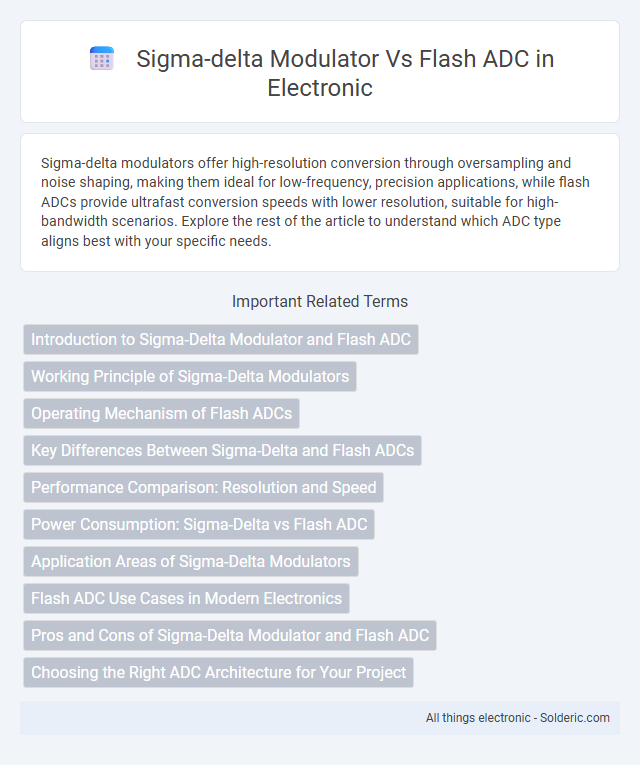Sigma-delta modulators offer high-resolution conversion through oversampling and noise shaping, making them ideal for low-frequency, precision applications, while flash ADCs provide ultrafast conversion speeds with lower resolution, suitable for high-bandwidth scenarios. Explore the rest of the article to understand which ADC type aligns best with your specific needs.
Comparison Table
| Feature | Sigma-Delta Modulator | Flash ADC |
|---|---|---|
| Conversion Method | Oversampling + Noise Shaping | Parallel Comparators |
| Resolution | High (typically 16-24 bits) | Low to Medium (typically 3-8 bits) |
| Speed | Low to Medium (up to a few MHz) | Very High (GHz range) |
| Complexity | Complex digital filtering required | Simple architecture |
| Power Consumption | Lower at low speeds | High power due to many comparators |
| Applications | Audio, instrumentation, precise measurements | High-speed data acquisition, radar, communications |
| Latency | Higher due to oversampling and digital filtering | Minimal |
| Cost | Moderate, dependent on filtering complexity | High, due to comparator array |
Introduction to Sigma-Delta Modulator and Flash ADC
Sigma-Delta Modulators use oversampling and noise shaping to achieve high-resolution analog-to-digital conversion, making them ideal for low-frequency, high-precision applications such as audio processing. Flash ADCs provide ultra-fast conversion speeds by using a resistor ladder and multiple comparators in parallel, enabling immediate digital outputs ideal for high-frequency or real-time systems. Your choice depends on the trade-off between resolution and conversion speed required by your application.
Working Principle of Sigma-Delta Modulators
Sigma-delta modulators operate by oversampling the input signal at a frequency much higher than the Nyquist rate and employing noise shaping to push quantization noise out of the band of interest. This process involves integrating the difference between the input signal and a feedback loop output, converting it into a high-frequency bitstream that is subsequently processed by a digital decimation filter to yield a high-resolution output. In contrast, flash ADCs perform instantaneous parallel quantization without oversampling, making sigma-delta modulators more suitable for applications requiring high resolution and lower sampling rates.
Operating Mechanism of Flash ADCs
Flash ADCs operate using a parallel array of comparators that simultaneously compare the input voltage to reference voltages, enabling ultra-fast conversion speeds. Each comparator generates a binary output indicating whether the input is above or below its reference, allowing immediate digital encoding of the analog signal. This architecture delivers high throughput but at the cost of increased power consumption and complexity as resolution increases.
Key Differences Between Sigma-Delta and Flash ADCs
Sigma-delta modulators use oversampling and noise shaping to achieve high-resolution analog-to-digital conversion, ideal for low-frequency, high-accuracy applications, while flash ADCs rely on parallel comparators for ultra-fast conversion speeds but with lower resolution. Sigma-delta ADCs excel in precision and linearity through digital filtering, whereas flash ADCs prioritize minimal latency, suitable for high-speed data acquisition. The choice between sigma-delta and flash ADCs depends on the trade-off between resolution, speed, power consumption, and complexity in specific electronic systems.
Performance Comparison: Resolution and Speed
Sigma-delta modulators excel in high-resolution applications, offering superior accuracy with resolutions often exceeding 16 bits due to oversampling and noise shaping techniques. Flash ADCs prioritize speed, providing conversion rates in the gigasamples per second range but typically with lower resolutions around 6 to 8 bits. Your choice depends on whether resolution or speed is more critical, as sigma-delta modulators are ideal for precision measurements, while flash ADCs suit ultra-fast signal processing tasks.
Power Consumption: Sigma-Delta vs Flash ADC
Sigma-Delta modulators typically consume less power than Flash ADCs due to their oversampling approach and simpler analog front-end, making them ideal for low-power applications. Flash ADCs require a large number of comparators operating simultaneously, leading to higher dynamic power consumption, especially at high sampling rates. Your choice should consider that Sigma-Delta ADCs excel in power efficiency for high-resolution conversions, while Flash ADCs trade power for speed and low latency.
Application Areas of Sigma-Delta Modulators
Sigma-delta modulators excel in high-resolution, low-frequency applications such as audio signal processing, instrumentation, and medical devices where precise analog-to-digital conversion is crucial. Their oversampling technique and noise shaping provide superior signal-to-noise ratio compared to flash ADCs, making sigma-delta modulators ideal for sensing and measurement equipment. You benefit from enhanced accuracy and reduced quantization noise in environments demanding high fidelity and low distortion.
Flash ADC Use Cases in Modern Electronics
Flash ADCs excel in applications requiring ultra-fast conversion speeds such as high-frequency radar systems, real-time video processing, and digital oscilloscopes. Their parallel architecture enables sampling rates in the gigasamples per second range, making them ideal for capturing transient signals with minimal latency. Despite higher power consumption and lower resolution compared to sigma-delta modulators, flash ADCs are preferred in scenarios prioritizing speed over precision.
Pros and Cons of Sigma-Delta Modulator and Flash ADC
Sigma-Delta modulators offer high resolution and excellent noise shaping, making them ideal for precision applications such as audio and sensor signal processing, but they suffer from lower sampling rates and increased latency compared to other ADC types. Flash ADCs provide ultra-fast conversion speeds suitable for high-bandwidth applications like radar and communication systems but have limited resolution and high power consumption due to the large number of comparators required. Choosing between Sigma-Delta and Flash ADC depends on the trade-off between speed, resolution, power efficiency, and system complexity in the target application.
Choosing the Right ADC Architecture for Your Project
Selecting the right ADC architecture depends on your project's speed, resolution, and power requirements. Sigma-delta modulators excel in high-resolution, low-frequency applications with excellent noise shaping and linearity, ideal for audio and sensor data acquisition. In contrast, flash ADCs provide ultra-fast conversion rates suitable for high-speed data capture but typically at the cost of lower resolution and higher power consumption.
sigma-delta modulator vs flash ADC Infographic

 solderic.com
solderic.com